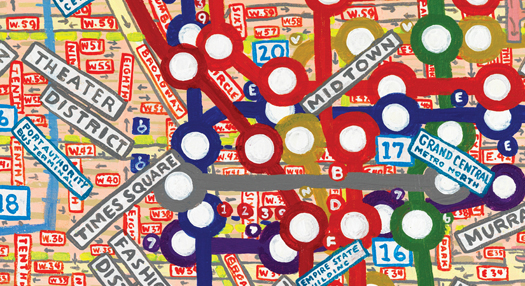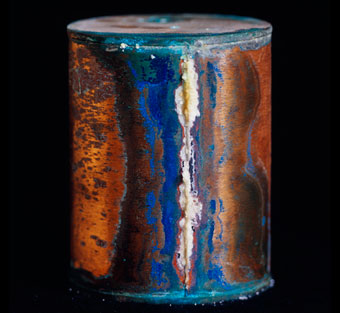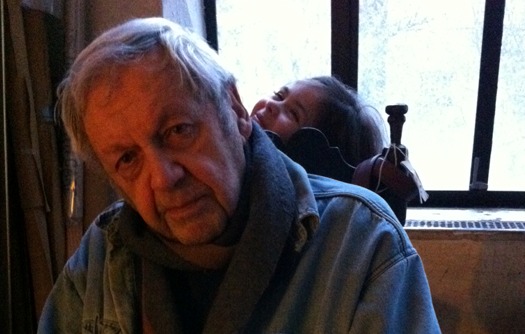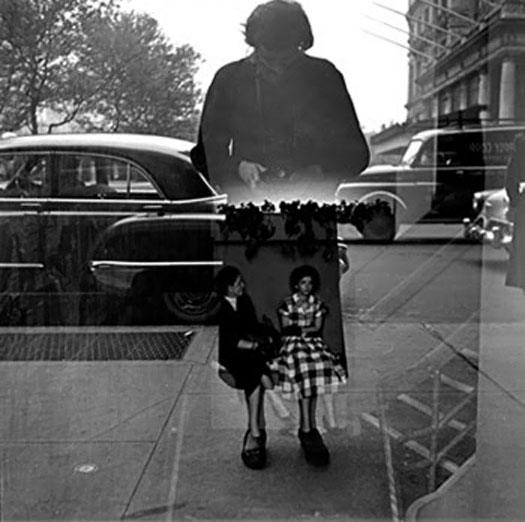
March 31, 2010
Finding Vivian Maier

A double exposure self portrait. Photo by Vivian Maier
In 2008, John Maloof purchased an anonymous body of photographic images at an auction in Chicago. After spending seven months reviewing the photographic material in his possession, he found written, almost illegibly on one of the sleeves of film, the name Vivian Maier.Â
With the help of genealogist Susan Berlowitz, Maloof found that Vivian Maier was
born in New York City and then moved to France while still very young. She returned
to the U.S. speaking and writing French, around the age of twelve and later became a nanny. Unfortunately, these details had unfolded a bit too late for John to ever meet her, she had passed away in April of 2009.Â
Following is an interview with John Maloof, now the archivist, curator and blogger of Maier’s highly accomplished body of work.
Michelle Hauser:
There is an expression in the auction-buying lexicon that one might say to oneself or to a potential rival to lay claim on a particular lot, “I am going home with it.” Â Is that how you felt when you clapped eyes on the cache of over 30,000 photographic negatives and rolls of undeveloped film being sold at auction?
John Maloof:
No, actually. I placed an absentee bid and left. I came back toward the end, to find that I had won the box of negatives. I was hoping to get them but my heart was not set on it.Â
MH:
Was it the sheer quantity of the lot that intrigued you? Did you have some inkling or premonition of the quality of the photographic images that were being sold?Â
JM:
At the time I was working on Portage Park, a book I co-authored, which is about a local Chicago neighborhood. At the time I was looking for images of Chicago and had found it hard to find unique vintage images of the city. Once I saw the iconic Chicago skyline in some of the negatives, I took a chance, thinking maybe I would be able use some of them for my book, but in the end, none were pertinent. I had no idea if this was just a bunch of snapshots or if they were taken by a pro.Â
MH:
You have stated that you did not have prior knowledge of street photography before you purchased the Vivian Maier archive. You must have had a prior interest in found photography. Or, no?Â
JM:
I was not into photography at all. In fact, as an impatient oil painter, I didn’t think that photography was a serious art. It was probably due to the fact that I didn’t know anything about it that I didn’t collect found images. The photographs were purchased to get more material for the book, but since none were used, they ended up in my closet for about half a year until I had time to scan some of them out of curiosity.
MH:
A fascinating aspect to this whole story is that Vivian’s work has schooled and inspired you to walk the streets of Chicago (with the same type of camera that she used), and that you have begun to photograph locations where she shot film. Until you started on this journey of photographing the street yourself, you hadn’t realized the caliber of her work?Â
JM:
That’s right. At first, I thought that the people in her pictures were unimportant. They seemed like snapshots or just boring. The urban landscapes are what caught my eye. It wasn’t until I started reading books on photography that I discovered street photography and street portraiture as a style. Then, I realized I was looking at her work the wrong way.Â
I started with the camera I had, which was a cheap digital point and shoot, but quickly moved into film. I eventually purchased a Rolleiflex like Vivian’s.Â
Once I had that Rolleiflex (and learned how to use it), it struck me at how difficult it is to use with freedom. It’s not like an SLR or rangefinder camera where you can tilt it, contort your body or even flip it upside down with ease, this camera was a small tank and you had to work around its limitations.Â
The learning process was intense — hit the streets, scan her negatives, hit the streets, compare my work to hers. This is the process I had to go through for over a solid year before I recognized her work as actually great (instead of just great to me.)Â
MH:
Is there any indication that Vivian was aware of other notable street photographers? For instance, was there a collection of her books or magazines being sold at that same auction that would provide insight? Â Â
JM:
Vivian had hundreds of books, mostly biographies, but she did have quite a few from well-known photographers — Robert Frank, Ansel Adams, Lewis Hine and many others.Â
MH:
From what I’ve gathered, Vivian did not print, or even bother to develop, the thousands of rolls of the film that she shot. She may have held back for financial reasons or because she lacked a proper darkroom. Or perhaps she shared the same sentiment expressed in the following quotations by Henri Cartier-Bresson: Â
“Your first 10,000 photographs are your worst.”
“Actually, I’m not all that interested in the subject of photography. Once the picture is in the box, I’m not all that interested in what happens next. Hunters, after all, aren’t cooks.”
It seems that Vivian’s appetite was for hunting. Have you developed any thoughts or theories on this? Also, have you noticed any reoccurring themes or locations in her work?
JM:
The reason she had a couple thousand undeveloped rolls of film is really hard for me to understand. I know that she had lived her life as a nanny/caretaker and, since her income wasn’t steady through the years, perhaps she had a point where she was too poor to develop. When she had money again, she may have just decided to develop what she was working on at the moment. It’s anyone’s guess.Â
There are recurring themes in her work for sure. She had a soft spot for children. From the earliest work up until the latest work, children found their way into her photos. She also had an interest in street graffiti and newspapers. Newspapers in stands, on curbs, in garbage cans, etc. But, her most recurring style would be her street portraits.Â
MH:
Had she achieved comparable recognition to Cartier-Bresson within her own lifetime, it would have been mandatory for her to make prints. But she was shooting film solely to please and express herself. Vivian Maier seems to have had the utmost confidence that she was getting the results she wanted. So am I correct in my understanding that you have yet to discover any prints by her?
JM:
I have prints by Vivian. She most likely found it difficult to control that end of the operation since she would be living with her employer and a darkroom was not always accessible. But, she managed to create prints, especially for her earlier work. And when color film became readily available in the 70’s, she jumped right in. With her lifestyle, it would definitely make sense to get into color since she could have the lab take care of both developing the film and printing.
MH:
In a 2003 Newsweek interview with Malcolm Jones called “The Man of the Moment,” Cartier-Bresson flippantly insisted over his wife’s objections “anyone with a camera is a photographer.” Â
What separates Vivian from an amateur, who is capable of making one or two outstanding images in a lifetime, is her willingness and ability to take thousands upon thousands of quality images. Vivian Maier produced a body of work. Do you agree that although she remained unknown during her lifetime that she went well beyond the realm of seasoned amateur and entered the pantheon of artist?
JM:
I completely agree. I have thought about that myself. Was it the era that made street photography easier? Was she out shooting at every spare moment? It amazes me how much work there is from her. If you think about it, I have about 100,000 negatives by her. If you created 2,000 negatives per year, it would have taken 50 years!
MH:
Many artists and photographers, myself included, are just as excited by how you came to possess Vivian Maier’s life work, as in the quality of the work itself. The story of your discovery brings hope to all working artists because it lends support to the conviction that the most important thing is to do the work. Â
If the artist does his or her part and produces a great body of work, not only will some enterprising young curator or novice find it, they will be enriched by their discovery and they will care for it. A legacy has been passed on to you by chance. How fitting, since her work records fleeting moments in life with such fearlessness. It is as if Vivian knew that it was only a matter of time before her work would be passed along, for someone else to complete the process. The aspect of being a photographer that did not seem to interest her is now in your domain. Vivian has not only been teaching you the art of photography (from the grave), she’s serendipitously given you an opportunity to develop a career by promoting and curating her incredible archive of photographic images. You seem to be up to the task. Do you ever feel burdened by the responsibility?
JM:
Not to sound gloomy for aspiring photographers but, I was only a hair away from never touching these again. I had purchased the remainder of the boxes from people who also did not realize the caliber of work they had in their possession. I’m afraid that if I wasn’t working on my book at the time these may have never been exposed, but who knows.Â
I don’t feel burdened at all. When I’m scanning her negatives I lose track of time as if I’m walking in her footsteps through these streets. I’m thankful to have found Vivian Maier.
Observed
View all
Observed
By Michelle Hauser

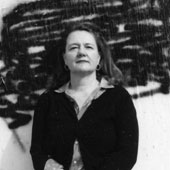 Michelle Hauser is a visual artist living in Maine. Along with her partner, Andrew Flamm, they founded
Michelle Hauser is a visual artist living in Maine. Along with her partner, Andrew Flamm, they founded 
